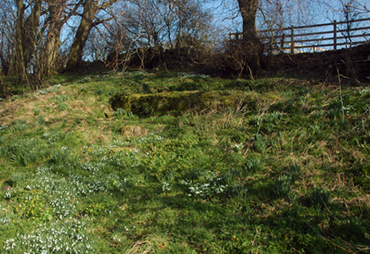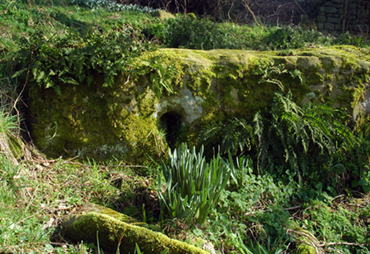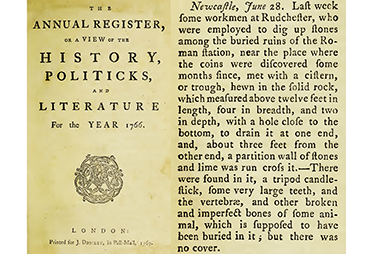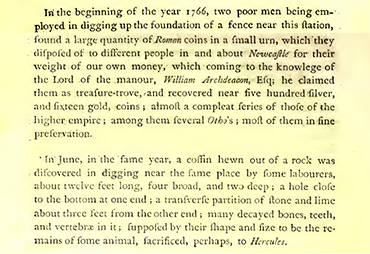Excavations 1766 - Giant's Grave
In 1760, a statue of Hercules was found in one of the Rudchester fields and and is now in the Great North Museum. In 1766 a Roman cistern, commonly known as the Giant's Grave, was uncovered nearby. It is about 4m long, 1.5m wide, 0.5m deep and appears to have been chiselled from bed rock. It has a tooled base draining to a hole in its south west corner. When discovered, it had masonary across it and contained many decayed bones and an iron implement described as being like a three-footed candle stick.

Hercules 1760
Click here for the original document in a new window:

Giant's Grave
Click here for a high resolution photograph in a new window:

Giant's Grave
Click here for a high resolution photograph in a new window:
Its use is unknown, although it could have been used for washing, tanning or perhaps brewing in the Roman Vicus. A manuscript written by Sir David Smith states thet "The old peasants here have a tradition that the Romans made a beverage somewhat like beer of the bells of heather (heath), and that this trough was used in the process of making such drink". There is also a Northumberland legend that the Picts had the art of preparing an intoxicating liquor from heather-bells and that died out with them.
There are two early accounts of the discovery of the so-called Giant's Grave in 1766. The first comes from "The Annual Register, or a view of the History, Politicks and Literature for the year 1766. London: Printed for J Dodsley, in Pall-Mall, 1767. The second is from "The Natural History and Antiquities of Northumberland and of so much of the County of Durham as lies between the Rivers Tyne and Tweed; commonly called, North Bishoprick, in two volumes by John Wallis AM. Vol. II. London. Printed for the author by W and W Strahan; and sold by S Bladon, in Pater-noster-Row. MDCCLXIX (1769)".

Annual Register 1766
Click here for the original document in a new window:

Wallis 1769
Click here for the original document in a new window:
The full text of the 1766 Annual Review article is:
Newcastle, June 28. Last week some workmen at Rudchester, who were employed to dig up stones among the buried ruins of the Roman station, near the place where the coins were discovered some months since, met with a cistern, or trough, hewn in the solid rock, which measured above twelve feet in length, four in breadth, and two in depth, with a hole close to the bottom, to drain it at one end, and, about three feet from the other end, a partition wall of stones and lime was run across it. There were found in it, a tripod candlestick, some very large teeth, and the vertebrae, and other broken and imperfect bones of some animal, which is supposed to have been buried.
We have not seen any evidence of a partition in the Giant's Grave, but I'll have a closer look in the Spring. The "tripod candlestick" is said to be in the Great North Museum.
The full text of the 1769 Wallis article is:
"Between the 9th and 8th mile stones, on the right hand, is the Roman station Vindobala (I – Horsley’s Brit. Romana), or Rouchester (m – Rouchester, Rowchester, etcetera Northumberland; Routchester, Camden). A sculpture of Hercules, in stone, of the rag-kind, was digged up at it by some labourers a few years ago, by whose carelessness it had the misfortune to lose both the head and feet. Mr. Brown, of Throckley-Fell, saved it from farther harm by having it carried to his house. In 1761, it was removed to London by a curious antiquary, Mr. Dunne, a gentleman, says Dr. Stukeley, who judiciously indulges a taste for the elegances of these learned curiosities, in the midst of the confinement and business of the law(n - Dr. Stukeley’s Caraus. Vol. i. p. 187. Vid. Hercules Ethnicorum, ex variis Antiq. Relig. delin. &c. Bejero,' cum 38 Fig. fol. 105.). The festival of Hercules and Bellona was observed, 3d June. Two Roman Fibulae have been also digged up, both of silver. One of them was in the possession of the Rev. Mr. Walton, of Corbridge, and the other of the late Mrs. Roberts, of Hexham. In passing by this station, 11th December 1761, I had a Roman brick and two coins from some labourers who turned them up from among the ruins the day before. The coins were of copper, and of the later empire. Upon the brick is the following inscription done with a stamp, the letters large and fair. LEG VIV [presumably 9th Legion]. In the beginning of the year 1766, two poor men being employed in digging up the foundation of a fence near this station found a large quantity of Roman coins in a small urn, which they disposed of to different people in and about Newcastle for their weight of our own money, which coming to the knowledge of the Lord of the manor, William Archdeacon, Esq; he claimed them as treasure-trove, and recovered near five hundred silver, and fifteen gold, coins; almost a complete series of those of the higher empire; among them several Otho's; most of them in fine preservation. In June, in the same year, a coffin hewn out of a rock was discovered in digging near the same place by some labourers, about twelve feet long, four broad, and two deep; a hole close to the bottom at one end; a transverse partition of stone and lime about three feet from the other end; many decayed bones, teeth, and vertebras in it; supposed by their shape and size to be the re-mains of some animal, sacrificed, perhaps, to Hercules. At the foot of the station, is Rouchester-Tower, the seat and manour of Robert de Rouchester, I K Edward I (o – Robertus de Rouchester tenet Rouchester per dimid. Slod. Vet. Feossam. Baren de Prudhow Escaet de anno I Ed I ) ; and of Gawen de Rotherforth, 10 Q. Elizabeth (pl; now in the possession of William Archdeacon, Esq; above-mentioned."
This account states that the statue of Hercules was discovered in 1760, 6 years before the Gaint's Grave. It is said to be in the Great North Museum.
The full text of the Lapidarium Septentrionale article is:
"Found at VINDOBALA, Rutchester ; now in the Castle at Newcastle. Wallis, in his History of Northumberland, Vol. II. , p. 167, has the following passage, under the head of VINDOBALA:-"A sculpture of Hercules in stone, of the rag kind, was digged up at it by some labourers a few years ago, by whose carelessness it had the misfortune to lose both the head and feet. Mr. Brown, of Throckley Fell, saved it from further harm by having it carried to his house. In 1761 it was removed to London by a curious antiquary, Mr. Duane, a gentleman, says Dr. Stukeley, who judiciously indulges a taste for the elegances of these learned curiosities, in the midst of the confinement and business of the law." Mr. Thos. Hodgson appends the following note to the statement:-"I have a strong suspicion that this figure never got further than Newcastle, and was that in possession of the Misses Peareth, and now in the collection at Newcastle." He is no doubt right. The statue probably owes its present mutilated condition to the uncultivated bands, who took possession of the station on the departure of the Romans, not to the labourers who discovered it. Nearly everything found upon the Wall bears decided marks of wanton violence. Hercules is here represented in the usual manner. His person is nude, and exhibits strong muscular development. He holds a ponderous club in his right hand; the apples of the garden of Hesperides are in his left. The skin of the Nemean lion is thrown over his shoulders..